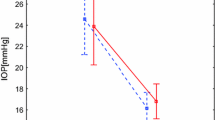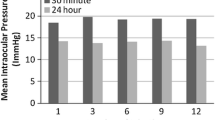Abstract
To evaluate the change in intraocular pressure (IOP) after pharmacologic dilation in eyes with primary open angle glaucoma (POAG), pseudoexfoliation glaucoma (PXG), and eyes of normal subjects. This cross-sectional study was conducted in a university hospital-based setting. Patients with PXG, POAG, and normal subjects were consecutively selected and included in the study. Of the 125 eyes of 125 subjects; 46 (25 female) had PXG, 42 (29 female) had POAG, and 37 (20 female) belonged to the control group. Pharmacologic dilation procedure consisted of instillation of topical phenylephrine HCL 10 % followed 5 min by tropicamide 1 %. Studied variables were pre- and post-dilation IOP and also baseline measurements of anterior chamber angle, central corneal thickness, and pupillary diameter by Pentacam HR (Oculus, Wetzlar, Germany). Clinically significant IOP change was defined as a change of ≥2 mmHg from baseline. Randomly selected single eye of each patient was included in the analysis. The mean pre:post-dilation IOP of eyes with PXG and POAG was 17.39 ± 3.89:17.54 ± 3.98 and 15.92 ± 2.37:16.07 ± 2.89 mmHg, respectively. The difference between the pre- and post-dilation IOP of eyes with PXG and POAG was not statistically significant. The eyes of control subjects, however, had a statistically significant reduction of IOP from 14.24 ± 2.88 to 13.54 ± 2.94 mmHg (P = 0.005). 28.3 % (13/46) of eyes with PXG, 16.7 % (7/42) of eyes with POAG, and 2.7 % (1/37) of control eyes showed a clinically significant IOP elevation from baseline after the dilation. In this study, glaucoma patients proportionally experienced a higher rate of clinically significant IOP elevation after pupillary dilation, when compared to normal subjects.

Similar content being viewed by others
References
Shaw BR, Lewis RA (1986) Intraocular pressure elevation after pupillary dilation in open angle glaucoma. Arch Ophthalmol 104:1185–1188
Tan GS, Wong CY, Wong TY, Govindasamy CV, Wong EY, Yeo IY, Aung T (2009) Is routine pupil dilation safe among Asian patients with diabetes? Invest Ophthalmol Vis Sci 50:4110–4113
Taner P, Unal B, Demirbaş E, Ergin A (2004) The effects of cyclopentolate on intraocular pressure and retrobulbar hemodynamics in patients with pseudoexfoliation syndrome and pseudoexfoliation glaucoma. Eur J Ophthalmol 14:394–400
Shihadeh WA, Ritch R, Scharf B, Liebmann JM (2009) Delayed intraocular pressure elevation after pupillary dilation in exfoliation syndrome. Acta Ophthalmol 89:560–562
Chen T (2005) Risk factors for intraocular pressure elevations after pupillary dilation in patients with open angles. Ann Ophthalmol 37:69–76
Harris LS (1968) Cycloplegic-induced intraocular pressure elevations a study of normal and open-angle glaucomatous eyes. Arch Ophthalmol 79:242–246
Razeghinejad MR, Pro MJ, Katz LJ (2011) Non-steroidal drug-induced glaucoma. Eye (Lond) 25:971–980
Siam GA, de Barros DS, Gheith ME, Da Silva RS, Lankaranian D, Tittler EH, Myers JS, Spaeth GL (2007) The amount of intraocular pressure rise during pharmacological pupillary dilatation is an indicator of the likelihood of future progression of glaucoma. Br J Ophthalmol 91:1170–1172
Valle O (1976) The cyclopentolate provocative test in suspected or untreated open-angle glaucoma. I. Effect on intraocular pressure. Acta Ophthalmol (Copenh) 54:456–472
Ritch R, Schlötzer-Schrehardt U (2001) Exfoliation syndrome. Surv Ophthalmol 45:265–315
Kass MA (1996) Standardizing the measurement of intraocular pressure for clinical research. Guidelines from the Eye Care Technology Forum. Ophthalmology 103:183–185
Musch DC, Gillespie BW, Niziol LM, Cashwell LF, Lichter PR, on behalf of the CIGTS Study Group (2008) Factors Associated with Intraocular Pressure Prior to and during 9 years of Treatment in the Collaborative Initial Glaucoma Treatment Study. Ophthalmology 115:927–933
Weinreb RN, Brandt JD, Garway-Heath DF, Medeiros FA, Brandt J, Liu J (2007) IOP as a risk factor for glaucoma development and progression. In: Weinreb RN, Brandt JD, Garway-Heath DF, et al. (eds) Intraocular pressure: reports and consensus statements of the 4th Global AIGS Consensus meeting on intraocular pressure. WGA Consensus Series 4. Kugler, The Hague, p 59–74
Hancox J, Murdoch I, Parmar D (2002) Changes in intraocular pressure following diagnostic mydriasis with cyclopentolate 1 %. Eye 16:562–566
Qian CX, Duperré J, Hassanaly S, Harissi-Dagher M (2012) Pre- versus post-dilation changes in intraocular pressure: their clinical significance. Can J Ophthalmol 47:448–452
Kim JM, Park KH, Han SY, Kim KS, Kim DM, Kim TW, Caprioli J (2012) Changes in intraocular pressure after pharmacologic pupil dilation. BMC Ophthalmol 12:53
Tsai IL, Tsai CY, Kuo LL, Liou SW, Lin S, Wang IJ (2012) Transient changes of intraocular pressure and anterior segment configuration after diagnostic mydriasis with 1 % tropicamide in children. Clin Exp Optom 95:166–172
Valle O (1974) Effect of cyclopentolate on the aqueous dynamics in incipient or suspected open-angle glaucoma. Acta Ophthalmol Suppl 123:52–60
Kristensen P (1965) Mydriasis-induced pigment liberation in the anterior chamber associated with acute rise in intraocular pressure in open-angle glaucoma. Acta Ophthalmol (Copenh) 43:714–724
Conway RM, Schlötzer-Schrehardt U, Küchle M, Naumann GO (2004) Pseudoexfoliation syndrome: pathological manifestations of relevance to intraocular surgery. Clin Experiment Ophthalmol 32:199–210
Wiederholt M, Thieme H, Stumpff F (2000) The regulation of trabecular meshwork and ciliary muscle contractility. Prog Retin Eye Res 19:271–295
Alm A, Nilsson SF (2009) Uveoscleral outflow: a review. Exp Eye Res 88:760–768
Atalay E, Tamçelik N, Capar O (2013) High intraocular pressure after carbamazepine and gabapentin intake in a pseudoexfoliative patient. J Glaucoma. doi:10.1097/IJG.0b013e318287aca7
Disclosure
The authors have no financial or proprietary interest to disclose.
Funding
None.
Author information
Authors and Affiliations
Corresponding author
Rights and permissions
About this article
Cite this article
Atalay, E., Tamçelik, N., Arici, C. et al. The change in intraocular pressure after pupillary dilation in eyes with pseudoexfoliation glaucoma, primary open angle glaucoma, and eyes of normal subjects. Int Ophthalmol 35, 215–219 (2015). https://doi.org/10.1007/s10792-014-9935-7
Received:
Accepted:
Published:
Issue Date:
DOI: https://doi.org/10.1007/s10792-014-9935-7




